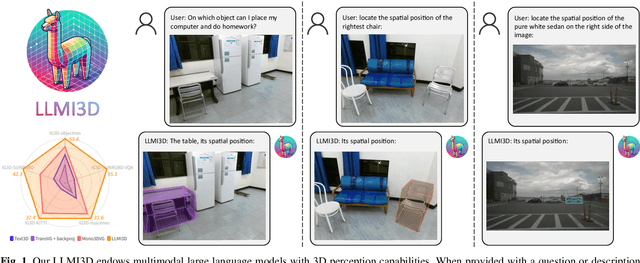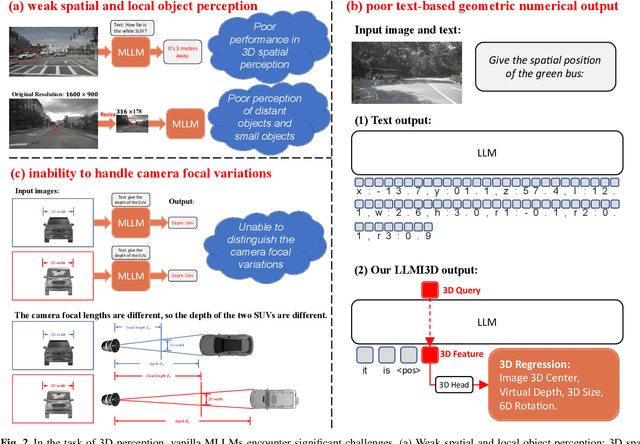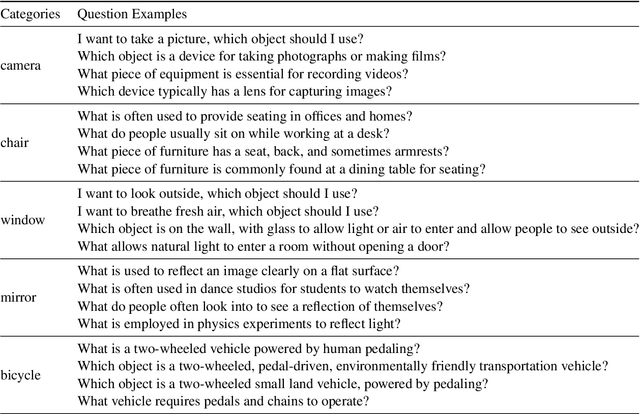Haonan Lu
MergeVQ: A Unified Framework for Visual Generation and Representation with Disentangled Token Merging and Quantization
Apr 01, 2025Abstract:Masked Image Modeling (MIM) with Vector Quantization (VQ) has achieved great success in both self-supervised pre-training and image generation. However, most existing methods struggle to address the trade-off in shared latent space for generation quality vs. representation learning and efficiency. To push the limits of this paradigm, we propose MergeVQ, which incorporates token merging techniques into VQ-based generative models to bridge the gap between image generation and visual representation learning in a unified architecture. During pre-training, MergeVQ decouples top-k semantics from latent space with the token merge module after self-attention blocks in the encoder for subsequent Look-up Free Quantization (LFQ) and global alignment and recovers their fine-grained details through cross-attention in the decoder for reconstruction. As for the second-stage generation, we introduce MergeAR, which performs KV Cache compression for efficient raster-order prediction. Extensive experiments on ImageNet verify that MergeVQ as an AR generative model achieves competitive performance in both visual representation learning and image generation tasks while maintaining favorable token efficiency and inference speed. The code and model will be available at https://apexgen-x.github.io/MergeVQ.
Improved Visual-Spatial Reasoning via R1-Zero-Like Training
Apr 01, 2025Abstract:Increasing attention has been placed on improving the reasoning capacities of multi-modal large language models (MLLMs). As the cornerstone for AI agents that function in the physical realm, video-based visual-spatial intelligence (VSI) emerges as one of the most pivotal reasoning capabilities of MLLMs. This work conducts a first, in-depth study on improving the visual-spatial reasoning of MLLMs via R1-Zero-like training. Technically, we first identify that the visual-spatial reasoning capacities of small- to medium-sized Qwen2-VL models cannot be activated via Chain of Thought (CoT) prompts. We then incorporate GRPO training for improved visual-spatial reasoning, using the carefully curated VSI-100k dataset, following DeepSeek-R1-Zero. During the investigation, we identify the necessity to keep the KL penalty (even with a small value) in GRPO. With just 120 GPU hours, our vsGRPO-2B model, fine-tuned from Qwen2-VL-2B, can outperform the base model by 12.1% and surpass GPT-4o. Moreover, our vsGRPO-7B model, fine-tuned from Qwen2-VL-7B, achieves performance comparable to that of the best open-source model LLaVA-NeXT-Video-72B. Additionally, we compare vsGRPO to supervised fine-tuning and direct preference optimization baselines and observe strong performance superiority. The code and dataset will be available soon.
H2VU-Benchmark: A Comprehensive Benchmark for Hierarchical Holistic Video Understanding
Mar 31, 2025Abstract:With the rapid development of multimodal models, the demand for assessing video understanding capabilities has been steadily increasing. However, existing benchmarks for evaluating video understanding exhibit significant limitations in coverage, task diversity, and scene adaptability. These shortcomings hinder the accurate assessment of models' comprehensive video understanding capabilities. To tackle this challenge, we propose a hierarchical and holistic video understanding (H2VU) benchmark designed to evaluate both general video and online streaming video comprehension. This benchmark contributes three key features: Extended video duration: Spanning videos from brief 3-second clips to comprehensive 1.5-hour recordings, thereby bridging the temporal gaps found in current benchmarks. Comprehensive assessment tasks: Beyond traditional perceptual and reasoning tasks, we have introduced modules for countercommonsense comprehension and trajectory state tracking. These additions test the models' deep understanding capabilities beyond mere prior knowledge. Enriched video data: To keep pace with the rapid evolution of current AI agents, we have expanded first-person streaming video datasets. This expansion allows for the exploration of multimodal models' performance in understanding streaming videos from a first-person perspective. Extensive results from H2VU reveal that existing multimodal large language models (MLLMs) possess substantial potential for improvement in our newly proposed evaluation tasks. We expect that H2VU will facilitate advancements in video understanding research by offering a comprehensive and in-depth analysis of MLLMs.
Layton: Latent Consistency Tokenizer for 1024-pixel Image Reconstruction and Generation by 256 Tokens
Mar 12, 2025Abstract:Image tokenization has significantly advanced visual generation and multimodal modeling, particularly when paired with autoregressive models. However, current methods face challenges in balancing efficiency and fidelity: high-resolution image reconstruction either requires an excessive number of tokens or compromises critical details through token reduction. To resolve this, we propose Latent Consistency Tokenizer (Layton) that bridges discrete visual tokens with the compact latent space of pre-trained Latent Diffusion Models (LDMs), enabling efficient representation of 1024x1024 images using only 256 tokens-a 16 times compression over VQGAN. Layton integrates a transformer encoder, a quantized codebook, and a latent consistency decoder. Direct application of LDM as the decoder results in color and brightness discrepancies. Thus, we convert it to latent consistency decoder, reducing multi-step sampling to 1-2 steps for direct pixel-level supervision. Experiments demonstrate Layton's superiority in high-fidelity reconstruction, with 10.8 reconstruction Frechet Inception Distance on MSCOCO-2017 5K benchmark for 1024x1024 image reconstruction. We also extend Layton to a text-to-image generation model, LaytonGen, working in autoregression. It achieves 0.73 score on GenEval benchmark, surpassing current state-of-the-art methods. Project homepage: https://github.com/OPPO-Mente-Lab/Layton
X2I: Seamless Integration of Multimodal Understanding into Diffusion Transformer via Attention Distillation
Mar 08, 2025Abstract:Text-to-image (T2I) models are well known for their ability to produce highly realistic images, while multimodal large language models (MLLMs) are renowned for their proficiency in understanding and integrating multiple modalities. However, currently there is no straightforward and efficient framework to transfer the multimodal comprehension abilities of MLLMs to T2I models to enable them to understand multimodal inputs. In this paper, we propose the X2I framework, which endows Diffusion Transformer (DiT) models with the capability to comprehend various modalities, including multilingual text, screenshot documents, images, videos, and audio. X2I is trained using merely 100K English corpus with 160 GPU hours. Building on the DiT teacher model, we adopt an innovative distillation method to extract the inference capabilities of the teacher model and design a lightweight AlignNet structure to serve as an intermediate bridge. Compared to the teacher model, X2I shows a decrease in performance degradation of less than 1\% while gaining various multimodal understanding abilities, including multilingual to image, image to image, image-text to image, video to image, audio to image, and utilizing creative fusion to enhance imagery. Furthermore, it is applicable for LoRA training in the context of image-text to image generation, filling a void in the industry in this area. We further design a simple LightControl to enhance the fidelity of instructional image editing. Finally, extensive experiments demonstrate the effectiveness, efficiency, multifunctionality, and transferability of our X2I. The open-source code and checkpoints for X2I can be found at the following link: https://github.com/OPPO-Mente-Lab/X2I.
GenX: Mastering Code and Test Generation with Execution Feedback
Dec 18, 2024



Abstract:Recent advancements in language modeling have enabled the translation of natural language into code, and the use of execution feedback to improve code generation. However, these methods often rely heavily on pre-existing test cases, which may not always be available or comprehensive. In this work, we propose a novel approach that concurrently trains a code generation model and a test generation model, utilizing execution feedback to refine and enhance the performance of both. We introduce two strategies for test and code data augmentation and a new scoring function for code and test ranking. We experiment on the APPS dataset and demonstrate that our approach can effectively generate and augment test cases, filter and synthesize correct code solutions, and rank the quality of generated code and tests. The results demonstrate that our models, when iteratively trained with an increasing number of test cases and code solutions, outperform those trained on the original dataset.
PainterNet: Adaptive Image Inpainting with Actual-Token Attention and Diverse Mask Control
Dec 02, 2024Abstract:Recently, diffusion models have exhibited superior performance in the area of image inpainting. Inpainting methods based on diffusion models can usually generate realistic, high-quality image content for masked areas. However, due to the limitations of diffusion models, existing methods typically encounter problems in terms of semantic consistency between images and text, and the editing habits of users. To address these issues, we present PainterNet, a plugin that can be flexibly embedded into various diffusion models. To generate image content in the masked areas that highly aligns with the user input prompt, we proposed local prompt input, Attention Control Points (ACP), and Actual-Token Attention Loss (ATAL) to enhance the model's focus on local areas. Additionally, we redesigned the MASK generation algorithm in training and testing dataset to simulate the user's habit of applying MASK, and introduced a customized new training dataset, PainterData, and a benchmark dataset, PainterBench. Our extensive experimental analysis exhibits that PainterNet surpasses existing state-of-the-art models in key metrics including image quality and global/local text consistency.
HEIE: MLLM-Based Hierarchical Explainable AIGC Image Implausibility Evaluator
Nov 26, 2024



Abstract:AIGC images are prevalent across various fields, yet they frequently suffer from quality issues like artifacts and unnatural textures. Specialized models aim to predict defect region heatmaps but face two primary challenges: (1) lack of explainability, failing to provide reasons and analyses for subtle defects, and (2) inability to leverage common sense and logical reasoning, leading to poor generalization. Multimodal large language models (MLLMs) promise better comprehension and reasoning but face their own challenges: (1) difficulty in fine-grained defect localization due to the limitations in capturing tiny details; and (2) constraints in providing pixel-wise outputs necessary for precise heatmap generation. To address these challenges, we propose HEIE: a novel MLLM-Based Hierarchical Explainable image Implausibility Evaluator. We introduce the CoT-Driven Explainable Trinity Evaluator, which integrates heatmaps, scores, and explanation outputs, using CoT to decompose complex tasks into subtasks of increasing difficulty and enhance interpretability. Our Adaptive Hierarchical Implausibility Mapper synergizes low-level image features with high-level mapper tokens from LLMs, enabling precise local-to-global hierarchical heatmap predictions through an uncertainty-based adaptive token approach. Moreover, we propose a new dataset: Expl-AIGI-Eval, designed to facilitate interpretable implausibility evaluation of AIGC images. Our method demonstrates state-of-the-art performance through extensive experiments.
LLMI3D: Empowering LLM with 3D Perception from a Single 2D Image
Aug 14, 2024



Abstract:Recent advancements in autonomous driving, augmented reality, robotics, and embodied intelligence have necessitated 3D perception algorithms. However, current 3D perception methods, particularly small models, struggle with processing logical reasoning, question-answering, and handling open scenario categories. On the other hand, generative multimodal large language models (MLLMs) excel in general capacity but underperform in 3D tasks, due to weak spatial and local object perception, poor text-based geometric numerical output, and inability to handle camera focal variations. To address these challenges, we propose the following solutions: Spatial-Enhanced Local Feature Mining for better spatial feature extraction, 3D Query Token-Derived Info Decoding for precise geometric regression, and Geometry Projection-Based 3D Reasoning for handling camera focal length variations. We employ parameter-efficient fine-tuning for a pre-trained MLLM and develop LLMI3D, a powerful 3D perception MLLM. Additionally, we have constructed the IG3D dataset, which provides fine-grained descriptions and question-answer annotations. Extensive experiments demonstrate that our LLMI3D achieves state-of-the-art performance, significantly outperforming existing methods.
GlyphDraw2: Automatic Generation of Complex Glyph Posters with Diffusion Models and Large Language Models
Jul 02, 2024Abstract:Posters play a crucial role in marketing and advertising, contributing significantly to industrial design by enhancing visual communication and brand visibility. With recent advances in controllable text-to-image diffusion models, more concise research is now focusing on rendering text within synthetic images. Despite improvements in text rendering accuracy, the field of end-to-end poster generation remains underexplored. This complex task involves striking a balance between text rendering accuracy and automated layout to produce high-resolution images with variable aspect ratios. To tackle this challenge, we propose an end-to-end text rendering framework employing a triple cross-attention mechanism rooted in align learning, designed to create precise poster text within detailed contextual backgrounds. Additionally, we introduce a high-resolution dataset that exceeds 1024 pixels in image resolution. Our approach leverages the SDXL architecture. Extensive experiments validate the ability of our method to generate poster images featuring intricate and contextually rich backgrounds. Codes will be available at https://github.com/OPPO-Mente-Lab/GlyphDraw2.
 Add to Chrome
Add to Chrome Add to Firefox
Add to Firefox Add to Edge
Add to Edge